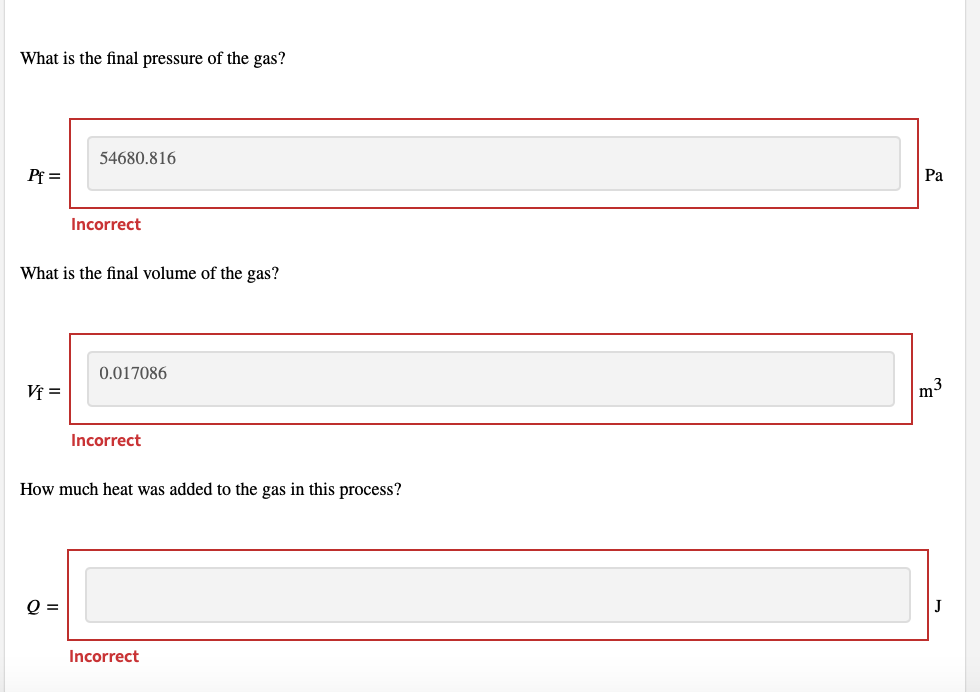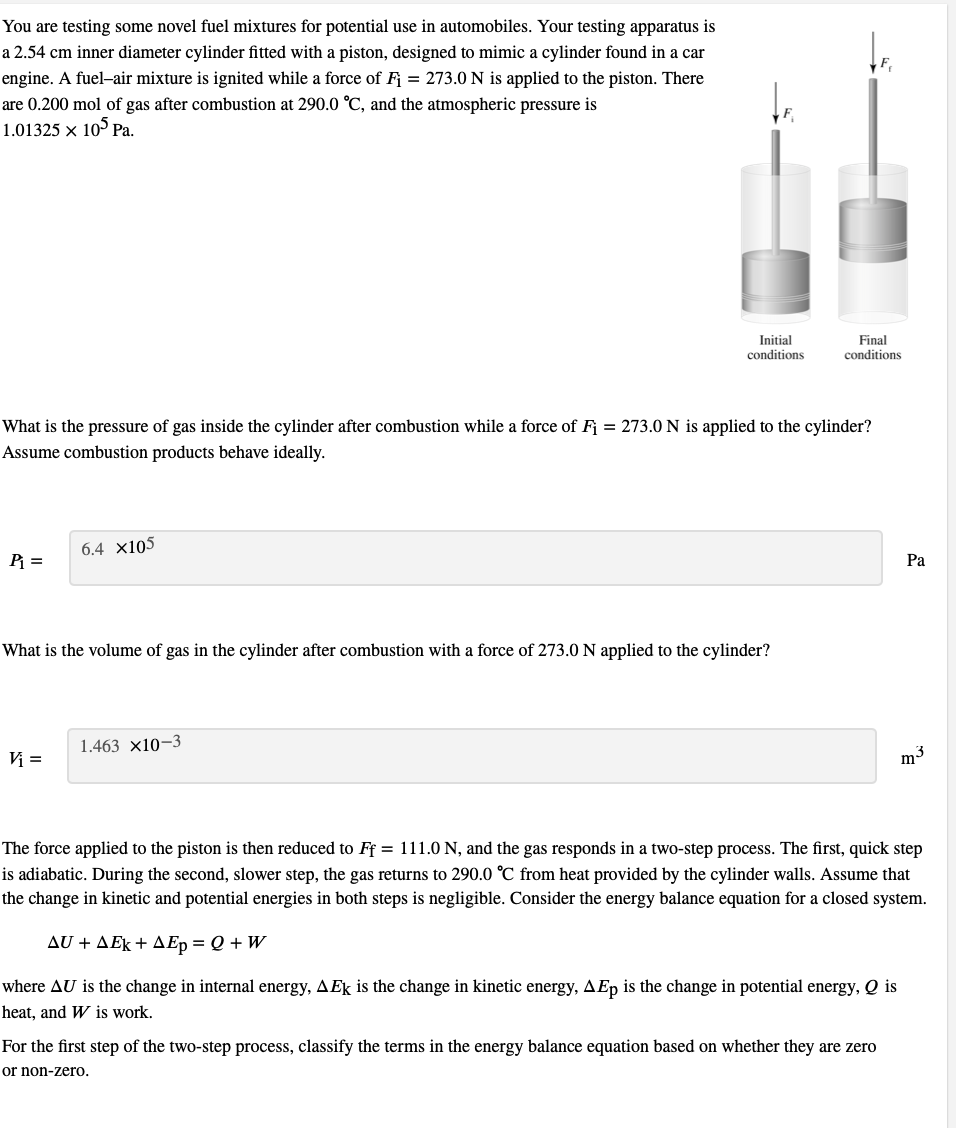You are testing some novel fuel mixtures for potential use in automobiles. Your testing apparatus is a 2.54 cm inner diameter cylinder fitted with a piston, designed to mimic a cylinder found in a car engine. A fuel-air mixture is ignited while a force of F = 273.0 N is applied to the piston. There are 0.200 mol of gas after combustion at 290.0 °C, and the atmospheric pressure is 1.01325 x 105 Pa. Initial Final conditions conditions What is the pressure of gas inside the cylinder after combustion while a force of Fj = 273.0 N is applied to the cylinder? Assume combustion products behave ideally. 6.4 x105 What is the volume of gas in the cylinder after combustion with a force of 273.0 N applied to the cylinder? 1.463 x10-3 V = The force applied to the piston is then reduced to Ff = 111.0 N, and the gas responds in a two-step process. The first, quick stej is adiabatic. During the second, slower step, the gas returns the change in kinetic and potential energies in both steps is negligible. Consider the energy balance equation for a closed systen 290.0 °C from heat provided by the cylinder walls. Assume that ΔU+ ΔΕk + ΔΕρQ+W where AU is the change in internal energy, AEk is the change in kinetic energy, AEp is the change in potential energy, Q is heat, and W is work. For the first step of the two-step process, classify the terms in the energy balance equation based on whether they are zero or non-zero.
You are testing some novel fuel mixtures for potential use in automobiles. Your testing apparatus is a 2.54 cm inner diameter cylinder fitted with a piston, designed to mimic a cylinder found in a car engine. A fuel-air mixture is ignited while a force of F = 273.0 N is applied to the piston. There are 0.200 mol of gas after combustion at 290.0 °C, and the atmospheric pressure is 1.01325 x 105 Pa. Initial Final conditions conditions What is the pressure of gas inside the cylinder after combustion while a force of Fj = 273.0 N is applied to the cylinder? Assume combustion products behave ideally. 6.4 x105 What is the volume of gas in the cylinder after combustion with a force of 273.0 N applied to the cylinder? 1.463 x10-3 V = The force applied to the piston is then reduced to Ff = 111.0 N, and the gas responds in a two-step process. The first, quick stej is adiabatic. During the second, slower step, the gas returns the change in kinetic and potential energies in both steps is negligible. Consider the energy balance equation for a closed systen 290.0 °C from heat provided by the cylinder walls. Assume that ΔU+ ΔΕk + ΔΕρQ+W where AU is the change in internal energy, AEk is the change in kinetic energy, AEp is the change in potential energy, Q is heat, and W is work. For the first step of the two-step process, classify the terms in the energy balance equation based on whether they are zero or non-zero.
Elements Of Electromagnetics
7th Edition
ISBN:9780190698614
Author:Sadiku, Matthew N. O.
Publisher:Sadiku, Matthew N. O.
ChapterMA: Math Assessment
Section: Chapter Questions
Problem 1.1MA
Related questions
Question

Transcribed Image Text:What is the final pressure of the gas?
54680.816
Pf =
Pa
Incorrect
What is the final volume of the gas?
0.017086
Vf =
|m3
Incorrect
How much heat was added to the gas in this process?
Q =
J
Incorrect

Transcribed Image Text:You are testing some novel fuel mixtures for potential use in automobiles. Your testing apparatus is
a 2.54 cm inner diameter cylinder fitted with a piston, designed to mimic a cylinder found in a car
engine. A fuel-air mixture is ignited while a force of F = 273.0 N is applied to the piston. There
are 0.200 mol of gas after combustion at 290.0 °C, and the atmospheric pressure is
1.01325 x 105 Pa.
Initial
Final
conditions
conditions
What is the pressure of gas inside the cylinder after combustion while a force of Fj = 273.0 N is applied to the cylinder?
Assume combustion products behave ideally.
6.4 x105
Ра
What is the volume of gas in the cylinder after combustion with a force of 273.0 N applied to the cylinder?
1.463 x10-3
V =
m3
The force applied to the piston is then reduced to Ff = 111.0 N, and the gas responds in a two-step process. The first, quick step
is adiabatic. During the second, slower step, the gas returns
the change in kinetic and potential energies in both steps is negligible. Consider the energy balance equation for a closed system.
290.0 °C from heat provided by the cylinder walls. Assume that
Δυ + ΔΕk + ΔΕ- Q+W
where AU is the change in internal energy, AEk is the change in kinetic energy, AEp is the change in potential energy, Q is
heat, and W is work.
For the first step of the two-step process, classify the terms in the energy balance equation based on whether they are zero
or non-zero.
Expert Solution
This question has been solved!
Explore an expertly crafted, step-by-step solution for a thorough understanding of key concepts.
This is a popular solution!
Trending now
This is a popular solution!
Step by step
Solved in 2 steps with 2 images

Knowledge Booster
Learn more about
Need a deep-dive on the concept behind this application? Look no further. Learn more about this topic, mechanical-engineering and related others by exploring similar questions and additional content below.Recommended textbooks for you

Elements Of Electromagnetics
Mechanical Engineering
ISBN:
9780190698614
Author:
Sadiku, Matthew N. O.
Publisher:
Oxford University Press

Mechanics of Materials (10th Edition)
Mechanical Engineering
ISBN:
9780134319650
Author:
Russell C. Hibbeler
Publisher:
PEARSON

Thermodynamics: An Engineering Approach
Mechanical Engineering
ISBN:
9781259822674
Author:
Yunus A. Cengel Dr., Michael A. Boles
Publisher:
McGraw-Hill Education

Elements Of Electromagnetics
Mechanical Engineering
ISBN:
9780190698614
Author:
Sadiku, Matthew N. O.
Publisher:
Oxford University Press

Mechanics of Materials (10th Edition)
Mechanical Engineering
ISBN:
9780134319650
Author:
Russell C. Hibbeler
Publisher:
PEARSON

Thermodynamics: An Engineering Approach
Mechanical Engineering
ISBN:
9781259822674
Author:
Yunus A. Cengel Dr., Michael A. Boles
Publisher:
McGraw-Hill Education

Control Systems Engineering
Mechanical Engineering
ISBN:
9781118170519
Author:
Norman S. Nise
Publisher:
WILEY

Mechanics of Materials (MindTap Course List)
Mechanical Engineering
ISBN:
9781337093347
Author:
Barry J. Goodno, James M. Gere
Publisher:
Cengage Learning

Engineering Mechanics: Statics
Mechanical Engineering
ISBN:
9781118807330
Author:
James L. Meriam, L. G. Kraige, J. N. Bolton
Publisher:
WILEY